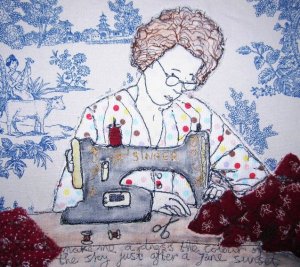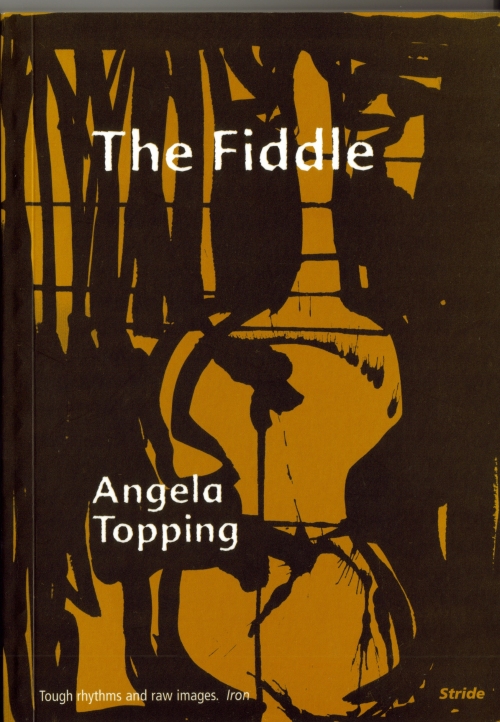The Next Big Thing, for those who don’t yet know, is a way to network with fellow writers and to find out a bit more about what they’re working on. The idea is fairly simple. The writer answers a set of questions on his or her blog one week, and then invites five other authors to answer the same questions the following week. They in turn invite five more.
I was invited by Geraldine Green
What is the title of your new book?
Paper Patterns

How did you choose the title?
I spent a long time deliberating this and then went back to my original idea. One of the poems is called Paper Patterns, and it came out of collaborating with a textile artist, Maria Walker. There are a few poems in the book which she has used on in her art work, and one of the sequences was written for a joint exhibition with her, all based on some family letters she had bought in a junk shop before she met me. After collaborating for a few months we met up, when we made the astonishing discovery that these letters she’d found so inspiring had been written by my father’s family. So the title reflects the work I had done with Maria.
The cover art is actually a piece of her work on which she embroidered words from the poem, Paper Patterns. I love that picture and she kindly gave me permission to have it as cover art. (Actually ALL my books have cover art by friends apart from my Salt books and my Rack Press pamphlet, because those publishers have a certain style and took charge of the covers for me.)
Also, the title resonates, because poems themselves are patterns on paper.
Where did the idea for the book come from?
As a poet, I tend to write the poems as I go along, and when I am putting a collection together, I think about which poems I want to include. Because this is a full length collection, it has several different themes and moods. It’s important to cut in some variety in poetry books. Although I know most readers will dip in and out, I have carefully arranged the poems so they speak to each other and take the reader on a journey throughout the book. For instance, the last few poems are about regrets and ageing, whereas near the start there are more light-hearted ones. The book also includes several sequences. One is The Lightfoot Letters which includes the poems written for the exhibition, another is Catching On, which brings together ten poems from the Rack Press pamphlet with 6 poems from my Salt collection I Sing of Bricks, about my friendship with poet Matt Simpson. There is also a new coda to that sequence, which charts the stages in our friendship and also the stages of coming to terms with his death. The third sequence is a small one of miniature poems in which wild plants speak their story.
Some of the poems were written on a course with Penelope Shuttle in France, and one was written after attending an inspirational reading by Pascale Petit. There are also some poems about birds, one of which was in Poetry Review, and several poems about fruit, written at a workshop by Jan Dean. Some were even written at my own workshops, where I tend to write as a way of timing the exercises and seeing whether they are good to work from. It’s not for me to track themes – I will leave that to the critics, who can be very perceptive.
What genre does your book fall under?
Poetry. It’s not highly experimental. I write poems which are accessible but complex in terms of their layers and resonances. I think every poem is an experiment. I tend to write instinctively and then bring my intellect to bear at the redrafting stage, where I am quite a harsh self-critic. I like poems which both stimulate the intellect but ultimately move the reader, so that’s how I aim to write.
What actors would you choose to play the part of your characters in a movie rendition?
That scenario is very unlikely in the case of a poetry collection. But sometimes poems are performed by actors. So actors I would most like to perform my work: David Tennant, Miriam Margoyles (who already did a splendid job with one of mine), Patrick Stewart, Frances Barber, Colin Firth, Dervla Kirwan, Sarah Lancashire.
Who has published your book?
My publisher is Lapwing, an independent press owned by Dennis Greig, who is based in Northern Ireland. He expressed an interest in my work when we were discussing, over email, a mutual friend, the late James Simmons. Dennis had published a few friends of mine including Janice Fitzpatrick, Ian Parks and Andrew Oldham. I felt that the house style would suit Maria Taylor’s artwork and Dennis and I very much see eye to eye on the current state of the poetry world, so I decided to send him my collection. I hope to do an Irish tour to promote the book, as soon as I have arrange some free time. I am of Irish descent and very proud of it. I’ve started to explore it more in my work.
What other books would you compare ‘The Other Side of the Bridge’ to, within the genre?
I think this one is best picked up by reviewers too. I hope I write in my own way and not leaning on the shoulders of others. My favourite poets include John Clare, Emily Dickinson, Robert Frost, Edward Thomas, Elizabeth Bishop, Matt Simpson, John Agard, Pablo Neruda, Ian Parks, Martin Figura, so it’s possible that their work and mine has some similarity. Helen Ivory is another poet I admire, as is George Szirtes, but I wouldn’t say this particular collection is similar to their poetry.
Who or what inspired you to write this book?
I think this book is a development from my earlier collections, although family and friends are still inspiring poems. Myth and nature are strong themes and everywhere I go I am writing poetry, so this book includes poems set in Egypt, France, different parts of the UK including London and Scotland, Whitby and the North York Moors. I also wanted to bring the sixteen elegies for Matt Simpson, which appeared in two different publications, together so I could finally call the sequence complete. I have touched on some of the elements that went into the book in my previous replies, also.
What else about the book might pique a reader’s interest?
I love it when people say to me that my poems have helped them work through difficult or meaningful times, like bereavement and childbirth. Readers can emotionally connect with my work; it’s not about me showing off or being clever, but a genuine attempt to communicate with others.
Also, I use a variety of forms, sometimes sonnets and other strict forms do the job, and other poems feel more comfortable in free verse.
The moods of the poems range too, and there is an unfolding narrative if one reads the collection in order.
Although I do write personal poems, I also reach further, for example I explore personae and history, myth and story. I also write for children and sometimes my playful side shows in my work for the general adult reader. I live a fairly ordinary life and celebrate the little things that provide moments of piercing joy.
What is the one sentence synopsis of your book?
The book’s blurb begins: Angela Topping unravels the threads that hold families and friends together, exposing the frailties, joys and tenacity of love, in these strong, spare poems.
I think that just about sums it up.
The following writers are contuining the tour. Do vist their blogs to see their responses to these questions:
Lindsey Holland
Adam Horowitz
Steve Ely
Catherine Edmunds http://catherineedmunds.blogspot.co.uk/
Fiona Sinclair








